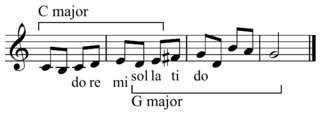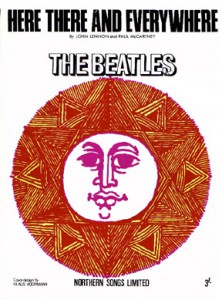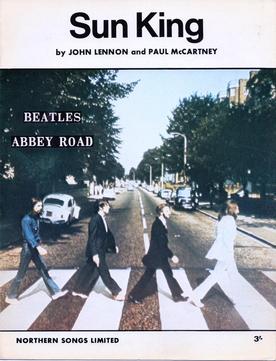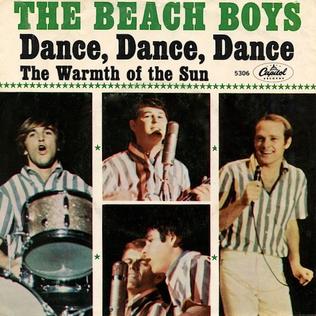In music theory, the key of a piece is the group of pitches, or scale, that forms the basis of a musical composition in Western classical music, art music, and pop music.
Tonality or key: Music which uses the notes of a particular scale is said to be "in the key of" that scale or in the tonality of that scale.
In a musical composition, a chord progression or harmonic progression is a succession of chords. Chord progressions are the foundation of harmony in Western musical tradition from the common practice era of Classical music to the 21st century. Chord progressions are the foundation of popular music styles, traditional music, as well as genres such as blues and jazz. In these genres, chord progressions are the defining feature on which melody and rhythm are built.

In music, modulation is the change from one tonality to another. This may or may not be accompanied by a change in key signature. Modulations articulate or create the structure or form of many pieces, as well as add interest. Treatment of a chord as the tonic for less than a phrase is considered tonicization.
Modulation is the essential part of the art. Without it there is little music, for a piece derives its true beauty not from the large number of fixed modes which it embraces but rather from the subtle fabric of its modulation.

In music theory, the circle of fifths is a way of organizing the 12 chromatic pitches as a sequence of perfect fifths.. If C is chosen as a starting point, the sequence is: C, G, D, A, E, B, F♯, C♯, A♭, E♭, B♭, F. Continuing the pattern from F returns the sequence to its starting point of C. This order places the most closely related key signatures adjacent to one another. It is usually illustrated in the form of a circle.

"Here, There and Everywhere" is a song by the English rock band the Beatles from their 1966 album Revolver. A love ballad, it was written by Paul McCartney and credited to Lennon–McCartney. McCartney includes it among his personal favourites of the songs he has written. In 2000, Mojo ranked it 4th in the magazine's list of the greatest songs of all time.
An augmented triad is a chord, made up of two major thirds. The term augmented triad arises from an augmented triad being considered a major chord whose top note (fifth) is raised. When using popular-music symbols, it is indicated by the symbol "+" or "aug". For example, the augmented triad built on A♭, written as A♭+, has pitches A♭-C-E:

"Good Vibrations" is a song by the American rock band the Beach Boys that was composed by Brian Wilson with lyrics by Mike Love. It was released as a single on October 10, 1966 and was an immediate critical and commercial hit, topping record charts in several countries including the United States and the United Kingdom. Characterized by its complex soundscapes, episodic structure and subversions of pop music formula, it was at the time the most expensive single ever recorded. "Good Vibrations" later became widely acclaimed as one of the finest and most important works of the rock era.
Song structure is the arrangement of a song, and is a part of the songwriting process. It is typically sectional, which uses repeating forms in songs. Common forms include bar form, 32-bar form, verse–chorus form, ternary form, strophic form, and the 12-bar blues. Popular music songs traditionally use the same music for each verse or stanza of lyrics. Pop and traditional forms can be used even with songs that have structural differences in melodies. The most common format in modern popular music is introduction (intro), verse, pre-chorus, chorus, verse, pre-chorus, chorus, bridge, and chorus. In rock music styles, notably heavy metal music, there is usually one or more guitar solos in the song, often found after the middle chorus part. In pop music, there may be a guitar solo, or a solo performed with another instrument such as a synthesizer or a saxophone.

The Andalusian cadence is a term adopted from flamenco music for a chord progression comprising four chords descending stepwise – a iv–III–II–I progression with respect to the Phrygian mode or i–VII–VI–V progression with respect to the Aeolian mode (minor). It is otherwise known as the minor descending tetrachord. Traceable back to the Renaissance, its effective sonorities made it one of the most popular progressions in classical music.

"Sun King" is a song by the English rock band the Beatles from their 1969 album Abbey Road. Written primarily by John Lennon and credited to Lennon–McCartney, it is the second song of the album's climactic medley. Like other tracks on the album the song features lush multi-tracked vocal harmonies, provided by Lennon, Paul McCartney and George Harrison.

"Dogs" is a song by English rock band Pink Floyd, released on the album Animals in 1977. This song was one of several to be considered for the band's 2001 compilation album Echoes: The Best of Pink Floyd.
"You Still Believe in Me" is a song by American rock band the Beach Boys from their 1966 album Pet Sounds. Initially conceived as "In My Childhood", it was the first songwriting collaboration between Brian Wilson, the group's de facto leader, and songwriter Tony Asher. Wilson sang the lead vocal.

"Sloop John B" is a Bahamian folk song from Nassau. A transcription was published in 1916 by Richard Le Gallienne, and Carl Sandburg included a version in his The American Songbag in 1927. There have been many recordings of the song since the early 1950s, with variant titles including "I Want to Go Home" and "Wreck of the John B".

"I'm Waiting for the Day" is a song by the American rock band the Beach Boys from their 1966 album Pet Sounds. Written primarily by Brian Wilson, the lyrics describe a man who is "waiting for the day" when the woman he loves will be ready to commit to a relationship with him. Wilson, alongside co-author Mike Love, are the only Beach Boys who appear on the recording.

"This Whole World" is a song by American rock band the Beach Boys from their 1970 album Sunflower. Written by Brian Wilson, the song features his brother Carl on lead vocals and is credited as a Beach Boys production. Earlier in the year, it had been included on the Warner Brothers promotional sampler album The Big Ball, and as a single, fronted with "Slip On Through", but did not make the U.S. or UK pop charts.

"Dance, Dance, Dance" is a song by the American rock band the Beach Boys from their 1965 album Beach Boys Today!. Written by Brian Wilson, Carl Wilson, and Mike Love, it was first issued as a single in October 1964, backed with "The Warmth of the Sun". "Dance, Dance, Dance" marked Carl's first recognized writing contribution to a Beach Boys single, his contribution being the song's primary guitar riff and solo.
"Don't Back Down" is a song by the American rock band the Beach Boys and the final track on their 1964 album All Summer Long. Written by Brian Wilson and Mike Love, the lyrics describe a group of surfers who "don't back down from that wave", explaining that they "gotta be a little nuts" to show the girls "who's got guts". It was the group's last surfing-themed song until 1968's "Do It Again".

"I Get Around" is a song by American rock band the Beach Boys and the opening track from their 1964 album All Summer Long. Written by Brian Wilson and Mike Love, the autobiographical lyrics describe the group's reaction to their newfound fame and success, as well as their restlessness concerning the status quo, and their desire to find new places "where the kids are hip". It was released as a single on May 11, 1964, with the B-side "Don't Worry Baby".
"All the Things You Are" is a song composed by Jerome Kern with lyrics written by Oscar Hammerstein II.
The I–V–vi–IV progression is a common chord progression popular across several genres of music. It uses the I, V, vi, and IV chords of a musical scale. For example, in the key of C major, this progression would be C–G–Am–F. Rotations include:












